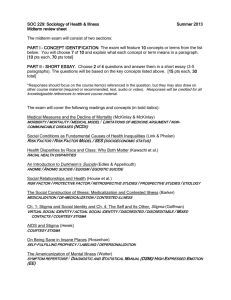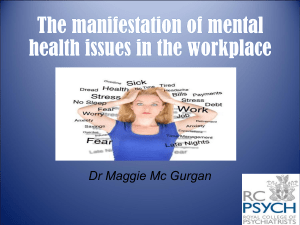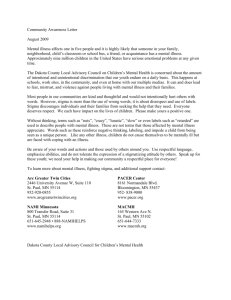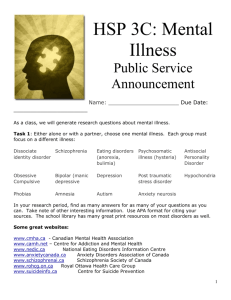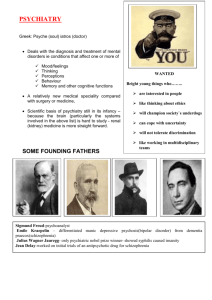Eliminating the Stigma of Mental Illness in the Schools
advertisement
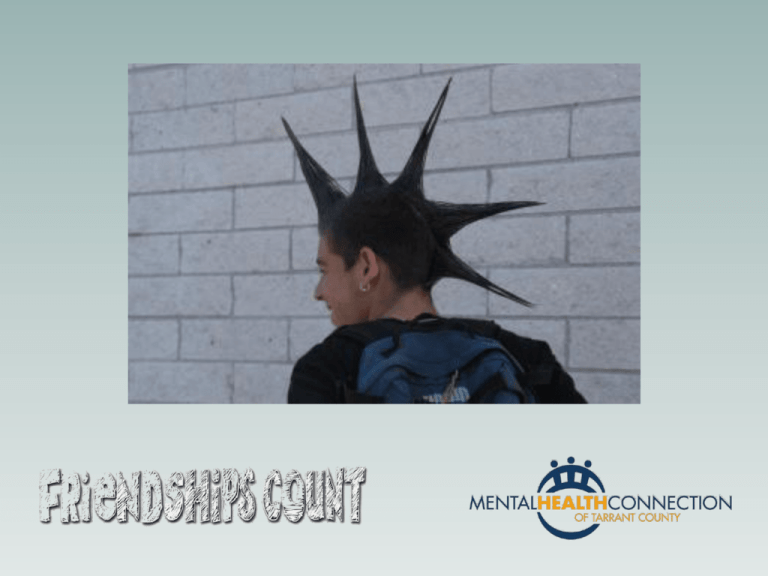
“Photo courtesy of Rex Geissler, GCI http://greatcommission.com Eliminating the Stigma of Differences What were your reactions to each of these pictures? Why did you have those reactions? When we see someone we might like, what do we see? What about someone we don’t think we’ll like? Do we judge people by: The way they look? The clothes they wear? The way they wear their hair? Their reactions to us? Anything else? Stigma A sign of social unacceptability A mark of shame or discredit Stigma Why do we treat others differently? Stigma Why do we treat others differently? Why do people who are different sometimes scare us? Stigma Do you think others might see you as different in any way? Stigma What can you do to overcome the stigma of differences? Overcoming stigma Educate yourself about differences so you understand them better Stop others from making fun of people who are different Photo credit: Human Relations Media www.hrmvideo.com Overcoming stigma Be compassionate and understand some behaviors may be due to an illness Take care in what you say. Avoid hurtful words Stigma Stigma Mental Illnesses Can happen to anyone, of any age, anywhere. What is mental illness? A group of mental disorders that causes severe disturbances in thinking, feeling and relating. People with a mental illness often have difficulty dealing with daily life. What is mental illness? Changes in thinking, mood, behavior Decreases ability to function Leads to: pain disability injury loss of freedom death What causes mental illness? Changes or abnormalities in the brain’s chemistry What causes mental illness? General medical factors Psychological scars/emotional trauma Heredity What causes mental illness? Medications Some medications can trigger a mental illness) Street drugs and alcohol Studies show marijuana use can double the risk of developing a mental illness such as schizophrenia due to chemical changes in the brain caused by the drug Who can develop mental illness? Occurs in all ages, ethnicities and religions Males and females Research underway to learn more about the reasons people develop mental illness Teens and mental illness More than half of all chronic mental illnesses start by age 14 Three-fourths of all chronic mental illnesses start by age 24 (National Comorbidity Survey Replication, funded by the National Institute of Mental Health, 2005) Facts about mental illness Many cases of mental illness start with easy-tomiss symptoms, such as mild anxiety or shyness In most cases, these symptoms will ease over time and will not interfere with a person’s life But sometimes these mild symptoms can progress into severe depression, phobias and clinical anxiety Facts about mental illness On average, people wait between 4 and 23 years to receive treatment for their mental illness, depending on the illness Facts about mental illness Delays: Major Depressive Disorder years Bipolar Disorder Post-traumatic Stress Disorder (SOURCE: National Comorbidity Survey Replication | By Seth Hamblin - THE WASHINGTON POST) 8 years 6 years 12 years Mental illness is treatable Success rates: Depression Schizophrenia (first episode) Bipolar Disorder 65 to 70 percent 60 percent 80 percent Mental illness is treatable Reasons for delay in seeking treatment: Lack of knowledge Lack of medical insurance Stigma – afraid of what others will think Early intervention leads to a higher chance of recovery, but stigma delays treatment Stigma As it relates to mental illness: Negative attitudes and beliefs that lead to: Fear Rejection Avoidance Discrimination Stigma People’s reactions Bullying Harassment Violence Avoidance Fear Photo credit: Human Relations Media www.hrmvideo.com Stigma People’s reactions Name Calling: Crazy Weird Psycho Insane Loony Maniac Photo credit: Human Relations Media www.hrmvideo.com What people think • Almost 30% of all people in Tarrant County believe there is something about people with mental illness that makes it easy to tell them from “normal” people What people think • More than 40% believe anyone with a history of mental illness should not be allowed to run for public office • More than half believe major depression might be caused by the way a person was raised What people think • More than 40% believe major depression is caused by a lack of will power Stigma Result: People do not seek help for fear of rejection, discrimination, ridicule Photo credit: ABC-of-Yoga.com Stigma A student with a mental illness may: Feel embarrassed Hide symptoms Try to “self medicate,” often with street drugs Make bad choices to “fit in” Why fight stigma Today, suicide is the third leading cause of death among adolescents Why fight stigma? There is hope – people can and do recover from mental illness Why fight stigma? Without stigma, people with mental illness will be accepted and feel comfortable reaching out for help Why fight stigma? With early intervention, treatment may be more effective Why fight stigma? Perhaps teens will reach out for help if they: – Understand their symptoms – Do not feel embarrassed – Know they can recover Stigma Assignment: Find a picture and article about someone who seems different in the newspaper, a magazine or on the Internet. Stigma Without reading the article, write the following: – Why is this person different? – What is my first reaction to this person? Stigma Now read about the person and add the following to your paper: – Was I right about this person? – Why or why not? Stigma and mental illness Assignment: – Imagine someone you know has been hospitalized for a mental illness – Write a letter to that individual Stigma and mental illness Assignment – How many students know someone with a mental illness? – Hold a classroom discussion on the ways that person coped with the illness. Photo credit: © Braden David (2002, 2003) Types of mental illness • • • • Impulse Control Disorders Anxiety Disorders Mood Disorders Psychotic Disorders Misunderstood mental illnesses Schizophrenia – Not very common – NOT “split personality” or Multiple Personality Disorder Definition of Schizophrenia A serious mental illness that interferes with a person's ability to think clearly, distinguish reality from fantasy, manage emotions, make decisions and relate to others. Definition of Schizophrenia People with schizophrenia often see or hear things that are not there and may believe someone is controlling their minds Schizophrenia You may have heard about violence Few people with mental illness are violent Some studies show people with mental illness are more likely to become victims of violence than the rest of society Misunderstood mental illnesses Schizophrenia – Medications for schizophrenia are highly successful in treating the disease – When someone with schizophrenia takes the proper medications, that individual can be a fully functioning member of society Impulse Disorders Attention Deficit Hyperactivity Disorder (ADHD) Definition of ADHD People with Attention Deficit Disorder (ADD) are usually impulsive and have a short attention span. It can interfere with academics, social activities and work. Definition of ADHD People with ADHD have the same symptoms as those with ADD, plus they exhibit hyperactivity, which can result in an inability to sit still. Causes of ADHD • Chemical imbalances in the brain • May be inherited Typical symptoms of ADHD • • • • Inability to focus Always in motion Non-stop talking Difficulty waiting for a turn Typical symptoms of ADHD • Interrupting others • Not paying attention to details • Making careless mistakes • Easily distracted How ADD/ADHD Feels “When the teacher was talking and the person next to me was tapping a pencil, it was as if a threering circus was going on in my head.” Treatments for ADHD • Parents learning to help their children manage their behaviors • Classroom changes that will help the student. • When necessary, medication that helps people focus and relieves the constant need for movement Anxiety Disorders • Generalized Anxiety Disorder • Agoraphobia • Obsessive-Compulsive Disorder Anxiety Disorders • Phobias • Panic Disorder • Post-Traumatic Stress Disorder What are Anxiety Disorders? • Feelings of overwhelming fear and anxiety or worry • No obvious reason for these feelings • Can become worse without treatment Symptoms • • • • • Fear and worry Sweating Heart disturbances Upset stomach Dizziness Generalized Anxiety Disorder • Uncontrollable worrying about everyday things – health, money, family, work • Anticipating disaster Generalized Anxiety Disorder Additional Symptoms – Trembling – Muscular aches – Insomnia – Irritability Agoraphobia Fear of anyplace where there may be no escape if panic-like symptoms occur. May include: Driving Shopping Crowded places Traveling Standing in line Meetings Obsessive-Compulsive Disorder Recurring thoughts or obsessions that reflect exaggerated worry or fears Obsessive Compulsive Disorder Typical obsessions – Worry about contamination – Fear of behaving improperly – Fear of being violent Obsessive Compulsive Disorder Additional Symptoms – Unusual rituals or routines such as: • Washing hands • Repeating phrases • Hoarding (storing up and hiding away items) Phobias • Intense, sometimes disabling fear • Cause of fear poses little or no actual danger • Person usually recognizes the fear is irrational Common phobias • Arachnophobia – fear of spiders • Social phobia – fear of contact with crowds or social situations – Public speaking – Eating in public • Aerophobia – fear of flying Common phobias • Claustrophobia – fear of being trapped in small, confined spaces • Acrophobia – fear of heights • Emetophobia – fear of vomit Common phobias • Carcinophobia – fear of cancer • Brontophobia – fear of thunderstorms • Necrophobia – fear of death or dead things Panic Disorder • Feelings of terror that strike suddenly and repeatedly with no warning • Cannot predict when next attack will occur, creating more anxiety Panic Disorder Additional symptoms – Trembling – Tingling sensations – A feeling of choking Panic Disorder Additional symptoms: – Fear of dying – Fear of losing control – Feelings of unreality Post-traumatic Stress Disorder Definition: A psychological reaction that occurs after experiencing a highly stressing event such as: – Physical violence – Wartime combat – Natural disaster Post-traumatic Stress Disorder Children and adolescents can also have PTSD as a result of experiencing: – Physical violence, including witnessing violence – Major loss (death, divorce, removal from home) – Abuse – More Post-traumatic Stress Disorder Many young people with mental health problems have experienced trauma Post-traumatic Stress Disorder Symptoms – Depression – Anxiety – Flashbacks – Repeating nightmares Posttraumatic Stress Disorder Symptoms – Avoidance of reminders of event – Emotionally numb, especially with people once close Treatments • Antidepressant medication • Therapy – talking to a professional about the issues and working out ways to cope better with anxieties and fear ADHD and Phobias Assignment – Write a paper about something that scares you • Why does it scare you? • Is it a reasonable fear? • Do you wish you were not afraid of it? ADHD and Phobias Assignment – Review today’s lesson and list the reasons your fear is or is not a phobia Depression & Bipolar Disorder Depression Definition: A serious illness that causes feelings of extreme sadness and hopelessness that last more than two weeks Depression Causes – Brain chemistry – Other diseases – Medications – Heredity – Stressful life events Depression Symptoms in adolescents – Poor performance in school – Withdrawal from friends and activities – Lack of enthusiasm, energy or motivation – Anger and rage Depression Symptoms in adolescents – Overreaction to criticism – Feelings of being unable to satisfy ideals – Poor self esteem or guilt – Indecision, lack of concentration or forgetfulness – Restlessness or agitation Depression Symptoms in adolescents – Changes in sleeping or eating patterns – Substance abuse – Problems with authority – Self mutilation – Suicidal thoughts or actions Depression Treatments – Therapy – Medication Depression Types of therapy – Psychotherapy • Explore painful events or feelings • Learn coping skills Depression Types of therapy – Cognitive-behavioral • Helps change negative patterns of thinking and behaving Depression Types of therapy – Interpersonal and Family • Focuses on developing healthier relationships at home and at school Depression Medication – Antidepressants • Can help relieve the negative feelings and are commonly used in conjunction with therapy • Many kinds of antidepressants exist – if one does not work for a patient, another may Bipolar Disorder Definition An illness that causes a person’s mood to swing from “high” and/or irritable to sad and hopeless, sometimes with periods of normalcy in between Bipolar Disorder Causes – Biochemical imbalance – Heredity – Stressful life events that trigger the illness Bipolar Disorder Symptoms Mania • Excessive activity, restlessness, racing thoughts and rapid talking • Denial that anything is wrong • Extreme high feelings – person is on top of the world and even bad news and tragic events can’t change those feelings Bipolar Disorder Symptoms Mania • • • • Easily irritated or distracted Decreased need for sleep Unrealistic beliefs in one’s own powers or abilities Uncharacteristically poor judgment Bipolar Disorder Symptoms Mania • Ongoing period of behavior that is different from usual, such as dressing or acting differently Bipolar Disorder Symptoms Mania • Ongoing period of behavior that is different from usual Indifferent to personal grooming Delusions or hallucinations Bipolar Disorder Symptoms Mania • Drug abuse • Provocative, intrusive or aggressive behavior Bipolar Disorder The symptoms for the depressed state in someone with Bipolar Disorder are the same as those in someone who has depression. Bipolar Disorder It can be very difficult to diagnose Bipolar Disorder. People with the illness receive an average of 3.5 wrong diagnoses and take 8 to 10 years to get a proper diagnosis and begin receiving treatment Bipolar Disorder Treatment – Medication – Professional help (therapy) – Support from family, friends and peers Suicide • Suicide is the third most common cause of death among adolescents • Suicide is preventable Suicide Warning signs in addition to depression: – Talking openly about committing suicide – Talking indirectly about “wanting out” or “ending it all” Suicide Warning signs in addition to depression – Taking unnecessary or lifethreatening risks – Giving away personal possessions – Making final arrangements, saying goodbyes Suicide Additional warning signs in adolescents – Suicide threats, direct and indirect • It is NOT normal for teens to threaten suicide – Obsession with death – Poems, essays and drawings that refer to death Suicide Additional warning signs in adolescents – Dramatic change in personality or appearance – Irrational, bizarre behavior – Overwhelming sense of guilt or shame – Changed eating or sleeping patterns – Severe drop in school performance Suicide What you can do – Tell a trusted adult immediately – Be a friend and let the person know things can and will get better – Know severe depression is a disease that can be successfully treated Suicide What you can do – Call CARL (Community Assistance Resource Line) at 1-877-778-CARL • • • • 24/7 availability Staffed by trained clinical specialists Identify and help youth at risk for suicide Free and confidential –Find resources at www.tarrantcares.org Suicide Resources – Tarrant Cares (www.tarrantcares.org) – MHMR Crisis Line (817-335-3022) – Call 2-1-1 – Mental Health Association (817-335-5405) Depression & Bipolar Disorder Assignment: – Look through the newspaper, Internet and magazines to find someone who may have symptoms of depression or Bipolar Disorder. – Hold a classroom discussion: • What are the symptoms • What kind of help can this person receive? Suicide Assignment – Imagine you have a friend who says he (she) is thinking about killing himself (herself). – Hold a class discussion on actions people can take to prevent the suicide Stigma and mental illness Assignment – Hold a class discussion on reactions to people saying they need help for a possible mental illness. – Does a request for help mean the person is weak? – Why or why not? Support for others Assignment – Find someone in the newspaper, in a magazine or on the Internet who seems to need help of some kind – Write that person a letter of encouragement Stigma Assignment – Write a paper on the types of differences discussed during the past several days • Why is there a stigma attached to differences? • How can that stigma be overcome? • How can you personally help overcome that stigma?
